Latest News
Kitchen Chat and more…
Kitchen Chat and more…
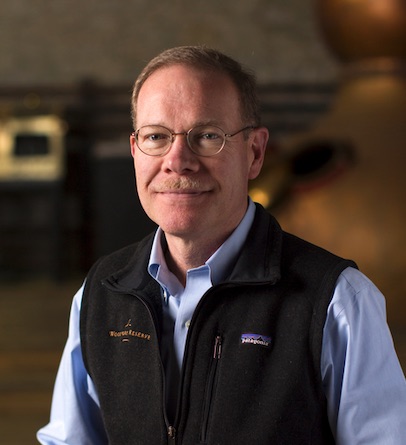
Chris Morris – Master Distiller, Woodford Reserve
The world of bourbon whiskey can be daunting if you do not know what you are drinking. The different expressions under one brand can be mind-boggling, and the struggle gets tougher when you face the various brands available. It is, therefore, a privilege to speak with Chris Morris, one of the most experienced Master Distiller under the Brown-Forman umbrella. Chris is the Master Distiller for Woodford Reserve, a whiskey that proves its mettle with its flavours.
We were unfortunate to miss the event hosted by Chris during his visit to Singapore a couple of weeks ago, but he was still kind enough to agree to an email interview with us.
Chris is the seventh Master Distiller at Brown Forman since the company began in 1870. Woodford Reserve, of course, is a brand under Brown Forman. Chris grew up in Louisville in a Bourbon family. Chris is one of the three generations in his family to work in the Bourbon industry. His father worked at Brown Forman before him. As a kid, Chris watched his mother enjoyed a glass of Old Forester while preparing dinner and played at the Old Forester Distillery whenever his dad brought him in during the weekends. These particular interactions with the Bourbon industry gave Chris a lasting impact, and he naturally went into the industry when he came of age.
Chris started his career as a trainee in the grain receiving lab and the sensory lab of Old Forester in 1976. His job included setting up barrel samples for the Master Distiller to taste besides running tests for the grains received. While the job sounded simple, it is essential because of the ingredients for the whiskey must be checked before the production team could use them. We asked Chris if much has changed since his time, considering the improvements in technology. Interestingly, he said that nothing much has changed except minor adjustments to improve the processes.
Chris moved on from Brown Forman after 12 years and joined Glenmore Distilleries Company in 1988. He then joined United Distillers when the firm acquired Glenmore in 1991. Chris gained experiences from these positions and became better at what he did. After nine years, he returned to the fold at Brown Forman.
His return proved to be the perfect timing. With his experiences, Chris was the forerunner as a candidate for the position of a trainee of the Master Distiller. He became the first Brown Forman Master Distiller designee to receive a formal training program. The course includes both academic and work experience requirements. It wasn’t the easiest course to train under, but it provides all the essential skills for a Master Distiller to become an expert in his role.
Chris mentioned that the program had been expanded to include a few additions that reflect the changes in the industry. This is the template for all future Master Distillers for Brown Forman. The current Assistant Master Distiller, Elizabeth McCall, is following the course.
Recently, there were debates about the Bourbon Tree, and what it meant for the Bourbon industry. We asked Chris for his opinions. “The Bourbon Tree is very interesting because it contains [several] inaccuracies that only an industry insider would recognize. It is also very simplistic in its portrayal of the diversity of Bourbon flavour development.” Chris said. He encouraged Bourbon lovers to research how the various brands crafted their bourbons, and judge the whiskey by its flavours, not its category.
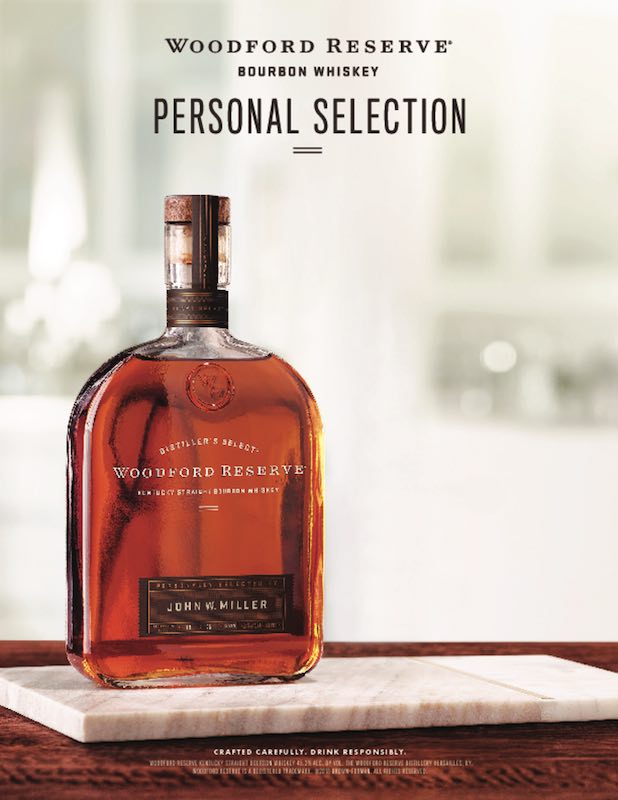
Woodford Reserve
Chris showed his passion for the Woodford Reserve when we began to ask questions about the bourbon. We came to understand that the bourbon is unique amongst the various brands because of its focus to flavours. The approach allows the brand to showcase flavour development and presentation that may not be possible in other brands. Woodford Reserve also created the Five Sources of Flavour production process philosophy to bring a balanced presentation of the Five Areas of Bourbon Flavours. This is why Chris is so proud of what Woodford Reserve has achieved so far.
Woodford Reserve has various expressions and families within its portfolio. Every expression brings a different flavour to the palate. Each bottle creates a unique experience for the bourbon lover. The expressions exist to showcase the different characteristics of bourbon, and are designed to be unbalanced on purpose. The Distillers Select range provides distinctive flavours for the drinker, and the bottles are probably not for someone who is looking for a balanced dram.
For the drinker who is looking for a balanced dram to enjoy, look out for the Woodford Reserve Kentucky Straight Bourbon. It is the most balanced of all Bourbons and will provide hours of pleasure for the Bourbon lover.
If you are interested in wood finishes, check out the Woodford Reserve Double Oaked. This expression explores the flavours of barrel finishing and provides an insight into how wood influences changes the liquid. Finally, for the curious and open-minded, the Masters Collection and Distillery Series showcase unique flavour presentation through modern whiskey innovation.
We asked Chris for his opinions on the future of Bourbon. His simple reasoning resonances with our understanding of the current market sentiments. He said, “The future of any consumer product category is hard to predict. But based on a value system that places great store on extreme age claims, I don’t see Bourbon reaching the price levels of the select Malts and Cognac.”
The fact remains that whisky drinkers placed much emphasis on age statements – perhaps too much. However, just as Chris said, the future is hard to predict. It may come a day where the market matures far enough to focus on flavours more than age statements. We see much improvements and acceptance of younger whiskies now, so maybe that day is not that far away after all.
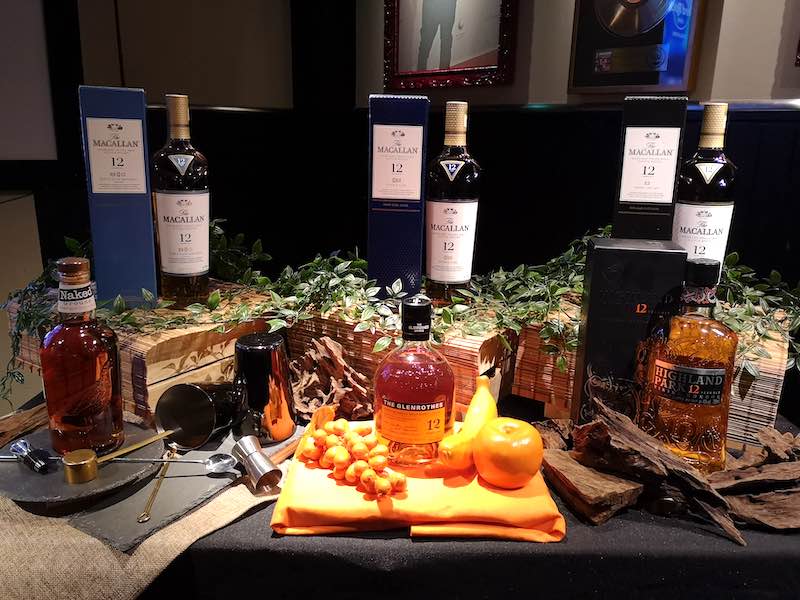
Whisky Line Up for the night
Most of us are familiar with Hard Rock Cafe, the hippy American rock cafe found almost everywhere in the world. However, most of us probably will not associate them with whiskies. Therefore, it was with surprise when we received an email from Hard Rock Cafe Singapore, requesting for WhiskyGeeks to assist them in a shout-out for a whisky tasting event happening on 15 May 2019. Of course, we helped, and the restaurant invited us to attend the tasting. The honour was all on us because we were the only media invited to the tasting.
We understood that the whisky tasting was held to celebrate the upcoming World Whisky Day (18 May). Hard Rock Cafe Singapore (HRCS) invited Randall Tan, the brand advocate from Edrington Group, to host the tasting and he kindly agreed. The line up was also one of the first of its kind that Randall did – A cross-brand tasting of Macallan, Glenrothes, Highland Park and their blended malt, Naked Grouse. We got to say that it was indeed the first ever cross-brand tasting that we did with Edrington Group and Randall.
It was a treat, to say the least, to be able to taste four different brands in one single tasting event.
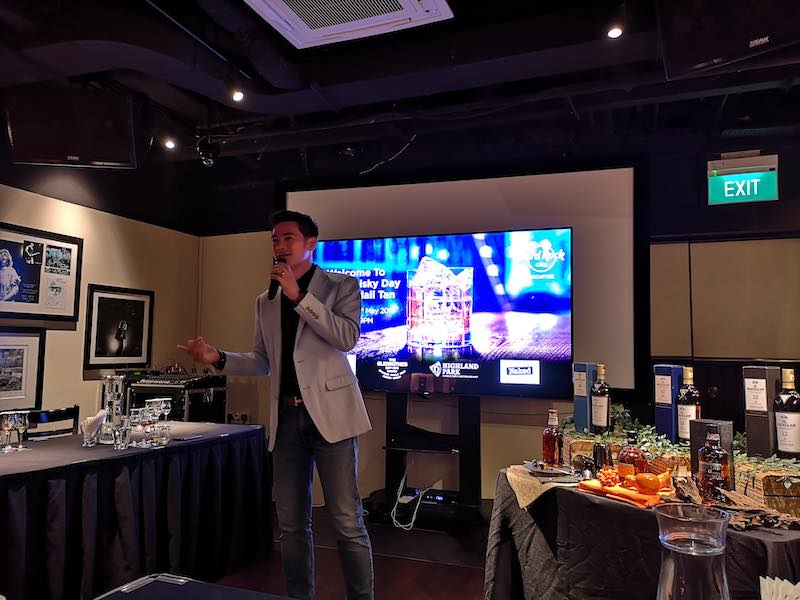
Randall Tan
Those of you who attended Macallan masterclasses would know Randall. We first got to know Randall many years back, when Macallan started the Toast the Macallan Masterclass series. It appeared that whisky is not only the water of life but also the fountain of youth. Randall doesn’t seem to have aged after ALL THESE YEARS! He still looks as youthful as always. Perhaps it was the lighting in the room?! Hahaha!
Anyway, it was good to see Randall again and listen to what he had to say. We thought the presentation was excellent because he shared much knowledge with the audience. From whisky making to distillation to maturation in casks, Randall offered up many nuggets of information to help the participants to learn more about whisky in general. Naturally, Randall also spoke about the different whiskies that we tasted, in more details.
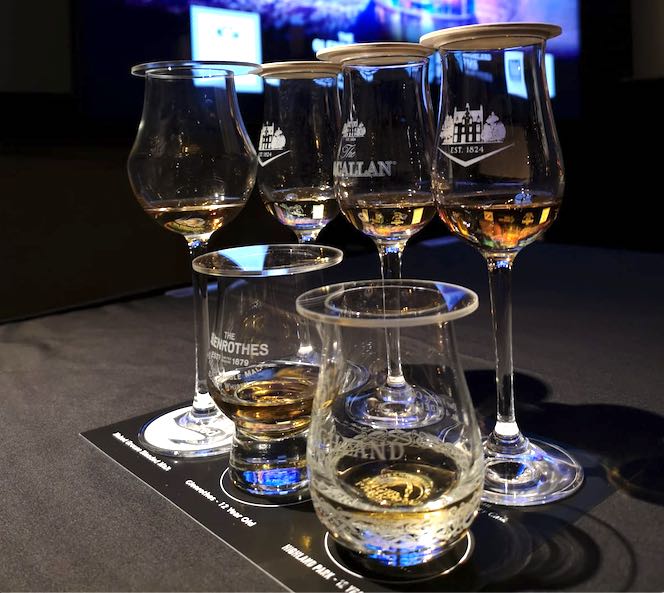
There were six whiskies on the table, and we tasted them all before. They were not something new, but there was a certain appeal to go back to the basics at times to appreciate the whiskies that we used to drink when we started our whisky journey.
The first whisky to start the night was the Naked Grouse. It is a blended malt now, with some of the best single malt whiskies that Edrington has ever produced being part of the blend. The whisky used to be a blended Scotch, and it was one of my favourite blends.
The new blended malt has Macallan, Highland Park, Glenrothes and Glenturret in it, and it is a parade of Edrington’s finest malt whiskies all in one. The individual whiskies are blended and then married in an oloroso sherry cask for six months as a finish before bottling. As a result, the sherry influence in the whisky is quite evident.
On the nose, we got Highland Park immediately. The honeyed notes, coupled with a waft of smoke before fading into the background. In a little moment, the influence of Macallan’s sherry notes came through. Glenrothes wafted in and out with its orange notes, and Glenturret was probably asleep as a base whisky. There were caramel, chocolate, cinnamon and hints of cherry.
The palate was mellow and pleasantly sweet. Caramel, milk chocolate, cherry soda were prominent, which probably were the Macallan and Glenrothes talking. There were also hints of oak and incense smoke which screamed Highland Park. I suppose the oaky bits could be the Glenturret. The finish was medium with some honey and oakiness to it.
Glenrothes is a brand that is often overshadowed by Macallan and Highland Park. Previously sold to the Chivas Brothers, the brand recently rejoined Edrington Group. The Group immediately did a rebranding for Glenrothes, and now the brand spots age-statements on their labels. In the past, they only showed the vintage, which confused some consumers.
Randall mentioned that there is no colouring added to the Glenrothes because the distillery works hard on their wood policy. We suppose it is an extension of Edrington Group as all the distilleries under their care take pride in their method of wood selection.
On the nose, sweet sherry, caramel and vanilla came through very quickly. As the whisky aired in the glass, we began to get hints of hay, citrus and oak. Slowly, the orange notes developed, and the combination of orange, sherry and vanilla made the nose extremely pleasant.
The palate was gentle and light, with caramel, sherry, cinnamon, citrus orange and hints of oak. The sherry-seasoned European oak cask used for maturation was evident in this whisky, especially when the whisky had time to air in the glass. The finish was short, oaky and sweet.
Now, we came to the Macallan 12 Years Old trio. First up was the Triple Cask. The three casks used in this whisky are ex-Bourbon American White Oak, sherry-seasoned American Oak and sherry-seasoned European Oak. The Macallan new make is matured for 12 years in each of these casks before getting married in a neutral (or spent) casks for a few months before bottling.
The citrusy nose was accompanied by vanilla and coconut from the American oak. There were hints of pepper and oak. On the palate, it was very light and maybe a little flat. The flavours were rather weak, with some vanilla, citrus and pepper. The finish was almost non-existent, and the whisky disappeared way too quickly.
The Macallan Double Cask was next. The casks used were sherry-seasoned European Oak and ex-Bourbon American White Oak. The Macallan new make is matured for 12 years in each of casks before getting married in neutral casks for a few months before bottling.
With the absence of the sherry American Oak, the influence of the sherry European Oak took over. The nose was full of toffee, burnt sugar, vanilla cream, raisin and bread crusts. There were also notes of cinnamon underneath. On the palate, toffee, cinnamon, and vanilla cream were prominent, with hints of raisins and pastry at the back. The influence of oak was also stronger.
Macallan is famous because of this whisky. We can almost call it the flagship whisky of Macallan. The 12 years old sherry cask, however, is different from what we used to enjoy. The old Macallan 12 Sherry Cask used barrels that held aged sherry. As the world evolved, people move away from aged sherry, and the old type of sherry casks was also gone. What Macallan uses now are sherry barrels that are seasoned with oloroso sherry for 18 to 24 months. Compared to the old Macallan 12 sherry cask, the current batches of 12 years old are very different indeed.
On the nose, we got clean sherry, caramel, cinnamon, raisins, candied oranges, milk chocolate and clove. The old familiar muskiness surfaced after a while, but it was nothing like the old Macallan 12. The palate was full of caramel, cinnamon, cherry, raisins, chocolate, cloves and spices. The finish was long, sweet and dry.
We must say that the new Macallan 12 Years Old is still a pleasant drink. Even though whisky drinkers who love sherry bombs may no longer like it, the Macallan 12 Sherry cask still pack a punch for the beginners. We found it rather pleasant; perhaps we no longer like sherry bombs?
Finally, we came to the last whisky – the Highland Park 12 Years Old. This whisky divided the opinion of Zico and me, mainly because he doesn’t mind the Highland Park while I dislike the light smoke. I always find the Highland Park too lightly smoked for me, as I much prefer stronger peated whisky such as Lagavulin 16 or the Octomores. Nonetheless, I was pleasantly surprised by the whisky this time.
On the nose, the heather honey was so strong! We must thank our newly-joined writer, Hong Fu, for giving us a taste of heather honey when he came back from Scotland last year. Perhaps it was the heather honey that made me feel better about Highland Park. Besides the heather honey, the nose was full of sweet vanilla, cinnamon, hints of toffee, and very light smoke.
The palate was again, heather honey, combined with vanilla cream, hay, cinnamon, nuts, green fruits and light smoke. It was nice. I actually enjoyed the Highland Park 12 for the first time! It was quite surprising for me, to be honest. The finish was medium, sweet and oaky.
Once the tasting was done, HRCS treated all of us like Kings and Queens. They served some of their signature dishes in small bite-size portions for us to enjoy. The only exception was their Hard Rock Slider, which appeared to be just a junior-sized burger.

The HRCS Food Galore
The food did not disappoint; for it was part of the Hard Rock signature. The food paired relatively well with some of the whiskies too!
The session came to an end around 9 pm, which I need to commend Hard Rock Cafe for keeping to the time. We hung around for a while, chatting with Randall, and the HRCS team. We also enjoyed another dram of Highland Park 12 Years Old. Haha…it was still amazing to me that I actually enjoyed it.
We learned from the HRCS team that they have promotions for most of the whiskies in the next few months.
Now to June – Macallan 12 Years Old Double Cask – $19/45ml or $225 for 1 bottle or $400 for 2 bottles
July to August – Glenrothes 12 Years Old – $17/45ml or $175 for 1 bottle or $320 for 2 bottles
September to October – Highland Park 12 Years Old – $17/45ml or $175 for 1 bottle or $320 for 2 bottles
These prices are affordable! Even if you are a seasoned whisky drinker, you may want to pop by to enjoy some basic drams when you are near HRCS. If you are starting out on your journey, why not pop by to try them? You may be surprised at how gentle a 40% whisky can be!
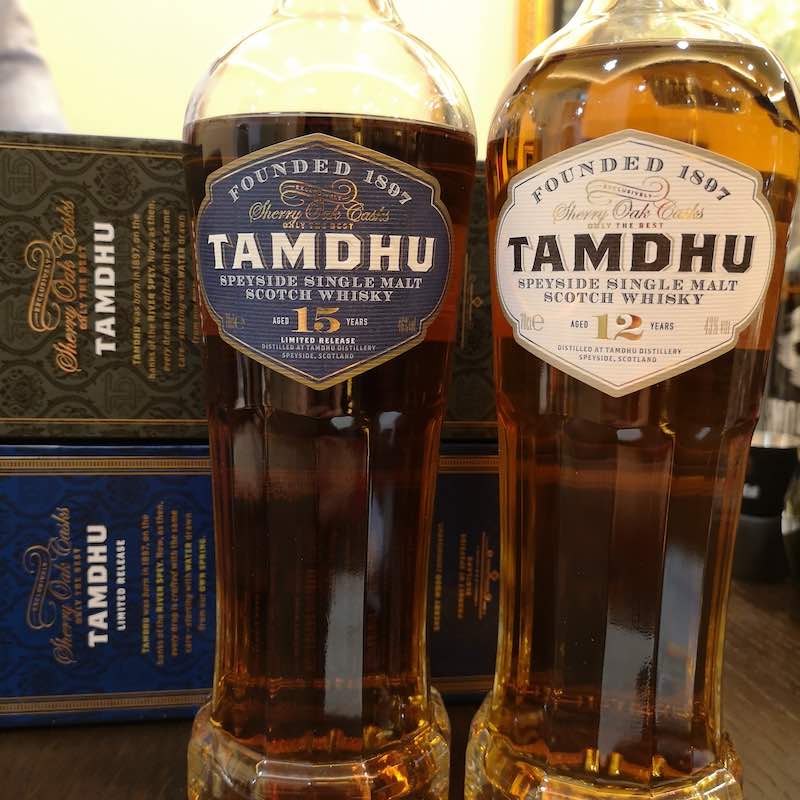
Tamdhu 12 and 15 Years Old
The last whisky review I did on WhiskyGeeks was a long time ago; 7 months ago, to be exact. There wasn’t a lot of time for me to sit around to relax and enjoy during these 7 months, so there wasn’t a point to do a review. I finally get some time today and worked myself into the mood to enjoy something nice.
I would like to change the scoring for our reviews from this post onwards – we will no longer score the whiskies based on a 20/20/20/40 system for the nose/palate/finish/balance. Instead, we will follow the standards by most whiskies review sites to use the 25/25/25/25 scoring system. I hope the change would make our scoring fairer.
I was given a sample of the Tamdhu 15 Years Old when I did the exclusive interview with Jonathan Scott. The Tamdhu 15 years old is the new kid on the block for their core range and the Asiaeuro team had graciously shared a sample with me. Here are my thoughts on it.
Colour: Amber
ABV: 46%
Nose: Oranges waft to the nose but cloves and cinnamon quickly replaced the sweet oranges. As I put aside the spices, I get sweet toffee, plums and some musky earth. (20/25)
Palate: Oily mouthfeel; sweet toffee envelops the mouth before the cloves work their way to give a spicy punch to the palate. Black pepper replaces the cloves after that. As the spices settle down, sweet toffee returns and bring along oranges, plums and honey to the palate. (23/25)
Finish: Long finish; the oranges linger for a short while before the cloves come back with a vengeance. Black pepper burns down the throat, giving an unexpected warmth. Finally, the finish turns dry and tannic, giving away to oakiness that lasts for a long time. (22/25)
Body: The Tamdhu 15 Years Old is a relatively complex dram that whisky lovers can enjoy for a long while. The spiciness of the dram may put some people off, but it does benefits from some airing or water. Once the whisky opens up, the sweetness of oranges, plums and honey takes the dram to another level. (23/25)
Total Score: 88/100
Comments:
Zerlina: I enjoyed this dram. On the surface, it looks like a simple whisky at 46% but the complexity of the dram is quite impressive. This is probably not so suitable for someone who just starts the whisky journey, but for someone who has been drinking whisky for a while, this will prove to be an enjoyable dram.
Zico: I am working on a cocktail at the moment – and hence will not be able to give an unbiased comment. Hahaha!
11311 Harry Hines Blvd
Dallas, TX, United States
(555) 389 976
dallas@enfold-restaurant.com
